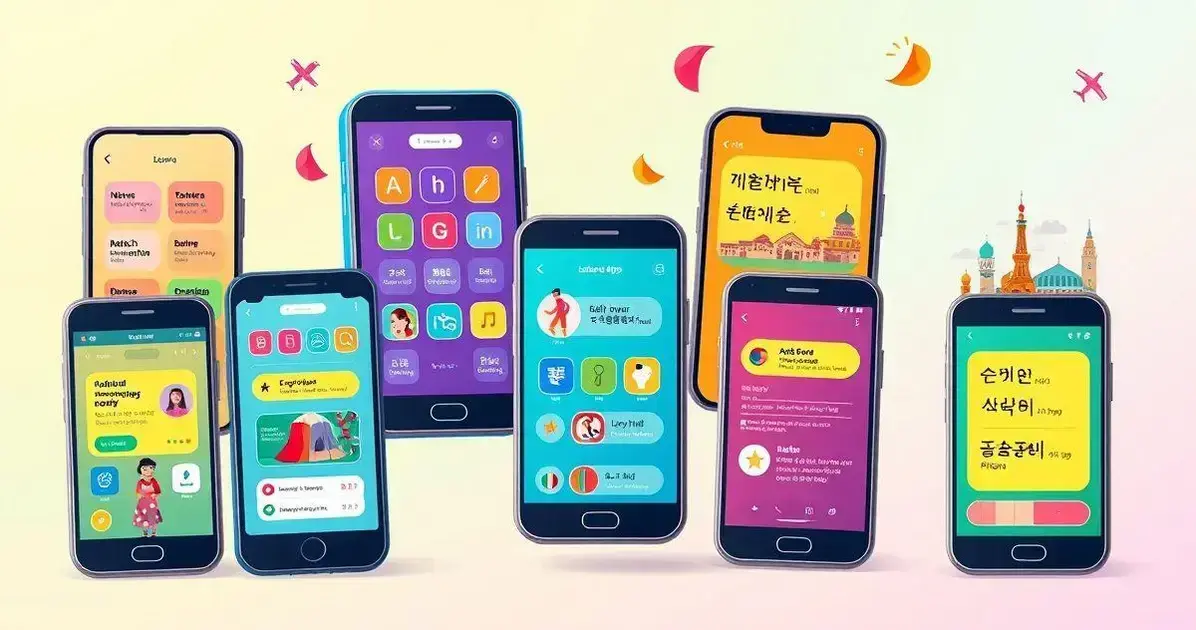Best Apps for Learning a New Language can truly accelerate your progress. With a range of options to fit different learning styles, choosing the right app is key to success.
From fun and gamified lessons to immersive, real-world practice, the right app can make language learning enjoyable and effective.
Curious about which apps stand out? Keep reading to find out which ones could be the perfect match for your language learning journey!
Top Language Learning Apps
When it comes to learning a new language, there are many apps available that cater to different learning styles and goals. Here are some of the top language learning apps you should consider:
1. Duolingo
Duolingo is a popular language learning app known for its gamified approach. Users learn through fun activities and short lessons that keep engagement high. It offers a wide range of languages and is suitable for beginners.
2. Babbel
Babbel is designed with a focus on conversation skills. Each lesson is crafted by language experts and tailored to help learners practice real-life dialogues. It’s especially good for those looking to build practical speaking abilities.
3. Rosetta Stone
Rosetta Stone is one of the oldest language learning platforms. It emphasizes immersive learning, teaching users through context and visual cues. This app is ideal for visual learners and those who want an in-depth understanding of the language.
4. Memrise
Memrise uses spaced repetition and mnemonic techniques to help learners memorize vocabulary and phrases effectively. The app includes videos of native speakers, which helps with pronunciation and understanding cultural context.
5. Pimsleur
Pimsleur is an audio-based language learning program which is perfect for auditory learners. It focuses on spoken language and emphasizes listening and speaking skills through engaging audio lessons.
6. Busuu
Busuu offers courses in 12 languages and has a unique feature that allows users to communicate with native speakers for practice. The app uses a structured learning plan and includes grammar exercises, making it suitable for serious learners.
These apps can provide valuable resources for learners at all levels. By choosing the right app that fits your learning style, you’ll be well on your way to mastering a new language!
How to Choose the Right App
Choosing the right app for learning a new language can greatly enhance your experience. Here are some key factors to consider:
1. Define Your Learning Goals
Before selecting an app, think about what you want to achieve. Are you looking to improve speaking skills, expand your vocabulary, or prepare for a trip? Defining your goals will guide your choice.
2. Assess Your Learning Style
Everyone learns differently. Some people are visual learners who benefit from images and videos, while others prefer auditory learning through sound and speech. Consider what engages you the most and look for apps that align with your style.
3. Check the Language Selection
Make sure the app offers the language you want to learn. Not all apps support every language, so validate that your target language is available before downloading.
4. Explore the Content and Structure
Review the app’s content and layout. Some apps focus on grammar, while others emphasize conversation. Look for apps that offer a balanced approach, integrating vocabulary, grammar, and speaking practice.
5. Read User Reviews
Check reviews from other users. These can provide insights into the app’s effectiveness and usability. Look for feedback regarding its features, pros, and cons, which can help you make an informed decision.
6. Try the Free Version First
Many language learning apps offer free versions or trial periods. Take advantage of these to get a feel for the app and see if it meets your expectations. You can decide if it’s worth investing in the premium version later.
By keeping these factors in mind, you can choose an app that best suits your needs and helps you achieve your language learning goals!
Features to Look For in Language Apps

When searching for the best language learning apps, certain features can significantly enhance your learning experience. Here are some key elements to consider:
1. User-Friendly Interface
A clear and intuitive interface is essential for effective language learning. The app should allow easy navigation and quick access to lessons without confusion.
2. Interactive Exercises
Look for apps that offer a variety of interactive exercises. These may include quizzes, flashcards, and speaking practice that engage users and reinforce learning.
3. Speech Recognition
Apps with speech recognition technology allow users to practice pronunciation. This feature gives immediate feedback and helps improve speaking skills.
4. Progress Tracking
Progress tracking features are important to gauge your improvement. The app should provide updates on lessons completed and areas that need more focus.
5. Diverse Learning Materials
Choose an app that offers diverse content, including videos, audio recordings, and texts. A variety of materials keeps learning dynamic and engaging.
6. Cultural Insights
Learning a language also involves understanding its culture. Features that provide cultural insights, idioms, and context can enrich your learning experience.
7. Community Support
Some apps include community features where users can interact, share knowledge, and practice together. This could be a great motivation and resource for learners.
By focusing on these essential features, you can select a language app that not only fits your needs but also makes learning an enjoyable experience!
User Reviews of Language Learning Apps
User reviews play a significant role in helping potential learners decide on language learning apps. Here’s what users are saying about some of the top choices:
Duolingo
Many users praise Duolingo for its fun and addictive learning style. They appreciate the gamification that makes studying enjoyable. However, some users feel that it lacks depth in grammar and advanced vocabulary.
Babbel
Babbel receives high marks for its emphasis on conversation skills. Learners love the real-world dialogues that help prepare them for real-life interactions. However, some find it less engaging than other apps.
Rosetta Stone
Users love Rosetta Stone’s immersive approach. They report that the app encourages thinking in the new language and helps with pronunciation. On the downside, some users think it’s costly and may not be suitable for casual learners.
Memrise
Memrise is noted for its entertaining content and use of mnemonics. Users claim that it effectively helps with vocabulary retention. However, some users wish it offered more structure in learning grammar.
Pimsleur
Pimsleur is highly regarded for its audio lessons, perfect for auditory learners. Users appreciate learning through listening, but some wish for additional visual aids.
Busuu
Busuu’s community feature allows learners to interact with native speakers, which users find invaluable. They enjoy getting feedback on their spoken language. Still, some feel the app could improve its lesson variety.
Reading user reviews can provide insight and help you pick the right app for your language learning journey!
Effective Language Learning Strategies
Using effective strategies can make learning a new language easier and more enjoyable. Here are some approaches to enhance your language learning:
1. Set Specific Goals
Start by setting clear, achievable goals. Whether it’s learning vocabulary or holding a conversation, having a target keeps you motivated.
2. Practice Regularly
Consistency is key! Try to practice every day, even if it’s just for a few minutes. Short, frequent sessions can be more effective than longer, less frequent ones.
3. Use Multiple Resources
Combine different learning tools such as apps, textbooks, podcasts, and videos. This variety helps reinforce what you’ve learned and keeps things interesting.
4. Engage with Native Speakers
Interacting with native speakers can greatly improve your skills. Look for language exchange partners, join meetups, or use apps that connect you with native speakers.
5. Immerse Yourself
Try to immerse yourself in the language as much as possible. This can include watching movies, listening to music, or reading books in that language to enhance your understanding and fluency.
6. Practice Speaking Out Loud
Speaking out loud helps you practice pronunciation and builds confidence. Don’t be afraid to make mistakes as they are part of the learning process.
7. Review and Revise
Regularly review what you’ve learned to reinforce your memory. Use flashcards or quizzes to assess your progress and revisit challenging topics.
By integrating these strategies into your routine, you can make the most of your language learning experience and see greater success!
Balancing App Use with Real-Life Practice

Using language learning apps is great, but real-life practice is equally important. Here are some ways to balance app use with real-world interactions:
1. Set Aside Time for Speaking Practice
Dedicate specific times each week to practice speaking with others. This can be with friends, language exchange partners, or even talking to yourself in the target language.
2. Join Language Classes or Meetups
Look for local language classes or meetups in your area. These provide structured learning and the chance to practice speaking with others in a supportive environment.
3. Combine App Learning with Daily Activities
Incorporate your language learning into daily tasks. Label items in your house, follow recipes, or watch your favorite shows in the target language to reinforce learning.
4. Engage with Native Speakers
Find opportunities to converse with native speakers. This could be through language exchange websites, social media groups, or even traveling to a country where the language is spoken.
5. Use Apps to Prepare for Real-Life Situations
Use apps to practice scenarios you might encounter, such as dining out, shopping, or asking for directions. Role-playing these situations makes you more comfortable when they occur in real life.
6. Create a Language Immersion Environment
Surround yourself with the language you are learning. Create playlists, listen to podcasts, and read books in that language to deepen your understanding and comfort.
By balancing app use with real-life practice, you can improve your language skills more effectively and enjoyably!
FAQ – Frequently Asked Questions About Best Apps for Learning a New Language
What are some of the best apps for learning a new language?
Some of the best apps include Duolingo, Babbel, Rosetta Stone, Memrise, Pimsleur, and Busuu, each offering unique features suited for different learning styles.
How do I choose the right language learning app?
Consider your learning goals, style, the languages offered, and read user reviews. Trying out free versions of apps can also help you make the best choice.
What features should I look for in a language app?
Look for a user-friendly interface, interactive exercises, speech recognition, progress tracking, diverse learning materials, cultural insights, and community support.
How important are user reviews for choosing an app?
User reviews provide valuable insight into the effectiveness and user experience of the app, helping you make an informed decision.
What are effective strategies for language learning?
Set specific goals, practice regularly, use multiple resources, engage with native speakers, immerse yourself, practice speaking out loud, and review often.
How can I balance app use with real-life practice?
Set aside time for speaking practice, join language classes, combine app learning with daily activities, engage with native speakers, and create a language immersion environment.